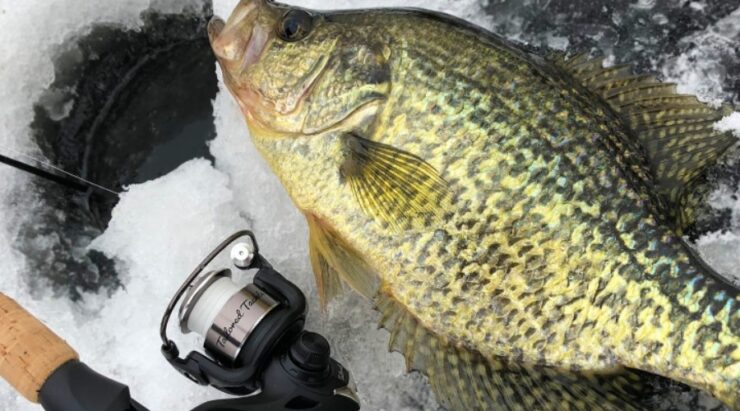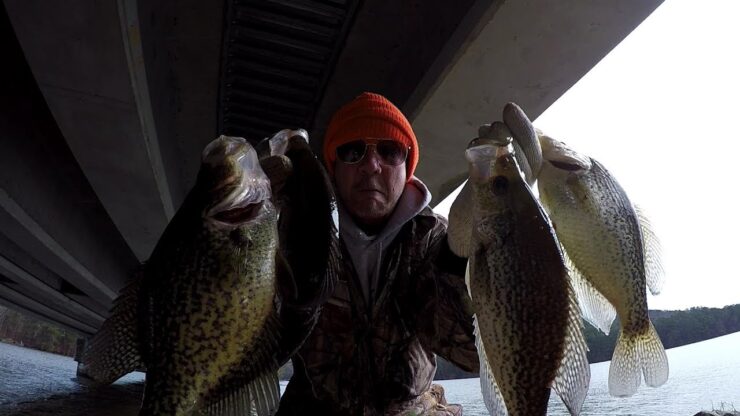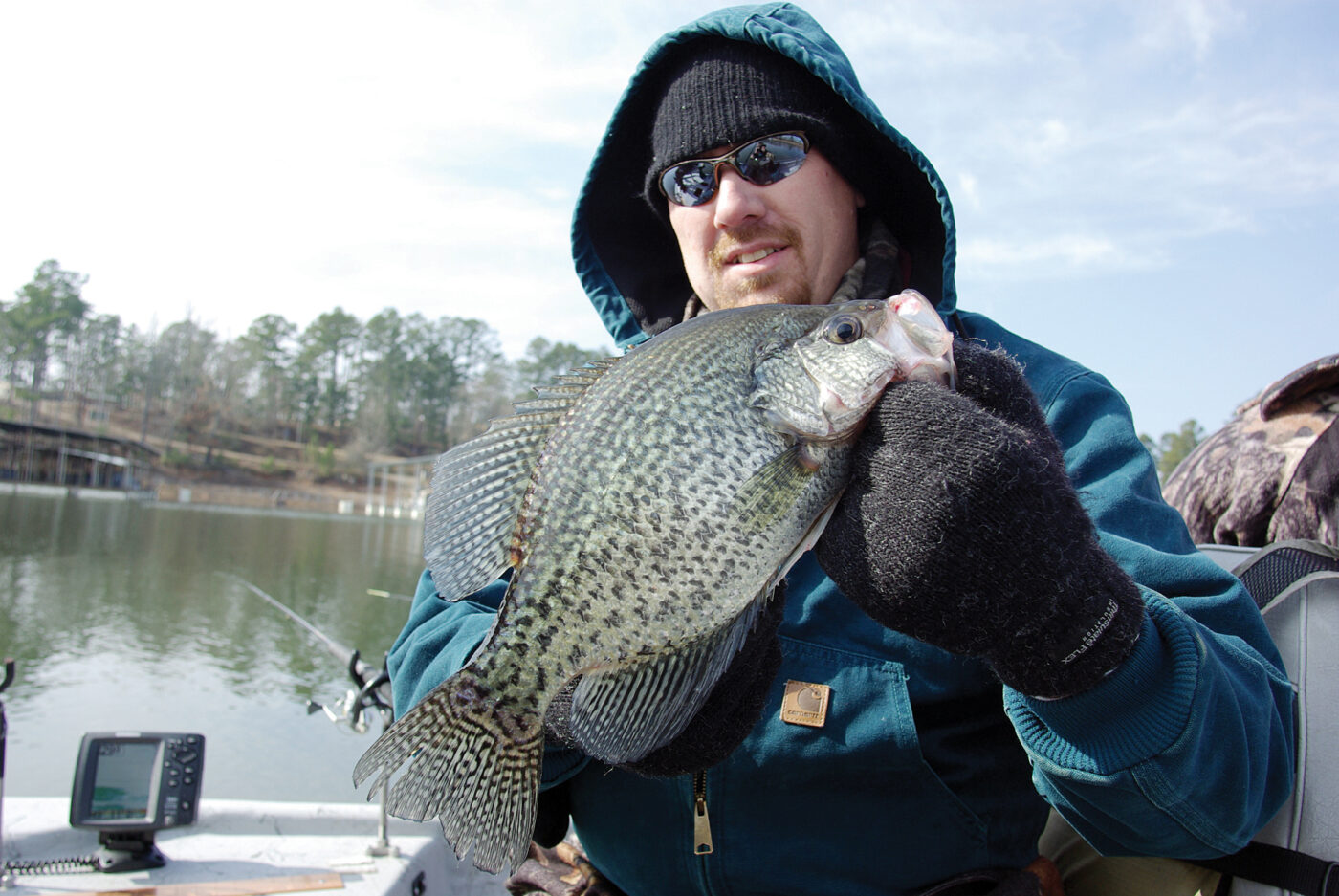When the temperatures drop, many people hang up their fishing rods and mope until spring. This would be a mistake. Winter crappie fishing can be some of the most fun of the year. You simply have to adjust your techniques slightly.
It is more than worth it to brave the cold and come home with your limit of slabs.
It’s not that hard to learn and can be as simple, or complicated as you want it to be. Winter crappie can be caught with a basic cane pole, ultra-light rigs, from shore, in a boat, from a dock, or even through the ice.
One advantage to fishing for crappie in the winter is you will have a lot less competition from other anglers, especially down South. A lot of people think crappie hibernate or are inactive in winter.
You will not have to deal with skiers, jet skiers, or most other things that can interfere with fishing (except maybe for the real hard-core water-lovers…). Also, the water always seems a little clearer and cleaner when it’s cold.
To be successful, you just need to do a little preparation and keep a few things in mind. Most importantly, make sure you have plenty of suitable warm clothing. Keep a lot of towels with you because you are probably going to get a little wet, and will need to dry off to prevent hypothermia.
It’s always best to dress in layers, so if you get too warm, you can take some off, and put it back on if it gets colder.
A thermos of hot coffee or tea is always a treat when engaged in cold weather outdoor activities. Other than that, you can just relax and enjoy the experience.
In the following sections, I will explain how crappie act in winter, where to find them, suitable equipment and bait to catch them with, and lots of great tips. Crappie may be a warm-water species, but nobody ever told them that. They just change up their behavior when the water gets into the 50s, and below, mostly to drive people crazy.
Anyone who doesn’t believe crappie has a sense of humor has never tried fishing for them in the middle of summer when they suspend in open water and refuse to hit anything unless it is almost placed in their mouths. Post-Solstice sac-a-lait are considerably more cooperative. When you are finished with this article, you will know how to put papermouths in the creel all winter long.
With that said, let’s get into some frosty fishing…
Table of Contents
ToggleColdwater Crappie Habits

Most crappie anglers already know that both Pomoxis species act differently during each season of the year. But, as I said in the introduction, a lot of anglers have the mistaken idea that crappie (as well as many other “warm water” species) become dormant or lethargic, and feed very little until the water temperature gets back into the 60s.
This is way wrong. Crappie feeds quite a lot in winter and continues to move around, but their eating habits vary somewhat, as do their movement destinations. They may not viciously strike at a 2-1/2″ minnow in winter, but they will happily nibble a 1″ jig (minnows don’t move a lot in cold water, but jigs do…).
For a winter crappie rig, think small and slow. The smaller, the better.
Crappie like much smaller bites in winter, and won’t move very far to get them. They also bite a lot more gently, so much so that you may not detect them on a light-action rod, or larger.
But, there is a fix for that I will go into later. For now, just think ultra-light rods, 4-lb line or less, and jigs no larger than 1/16 oz. Minnows need to be as close to 1″ as possible. Your hooks can be scaled back to #6, or even #8 light wire Aberdeen Long Shanks. The long shank makes it easier to remove the hook from the crappie’s mouth when your hands are cold (and they will be…).
The light wire will kill fewer minnows. I will go into more detail about actual mechanics later.
When the water temperature begins to drop below 55°F, crappie will begin to slow down on their voracious eating and begin moving to deeper water and suitable structure. They will move along channels, rip-raps, submerged creek beds, and will suspend in medium to large schools, usually near the thermocline, which can be anywhere from 20 to 50′ deep.
Since they will be in schools, it is not that hard to find them with a SONAR unit. Where you catch one, you will catch many. Once the temperature gets into the 40s, they will slow down their traveling, and stay in the immediate area unless disturbed by something like large predators, change in temperature, or if their food source moves.
They will almost always be found near schools of minnows and shad. When you find schools of minnows and shad, crappie will not be far away.
During the day, the north shore warms up quicker on most lakes, so crappie my migrate to that side as the day goes on. They also like confined waters, so channels, drop-offs, river mouths, and coves are good places to search. As night approaches, they will often move to shallower water in search of prey.
In the early morning, they will move back out, along lines of structure, usually the following baitfish.
The best times for catching crappie are in the early mornings, but they will bite all day and all night, with varying degrees of enthusiasm.
Bear in mind that none of this is written in stone. Each body of water is unique and crappie may act differently in each location. A good example is lakes that have steam plants for generating electricity. The waters near these are almost always 10 degrees warmer than the surrounding water, so crappie and other warm-water fish will naturally congregate to these locations, and may be more active.
Some lakes are shallow, others very deep. All of these factors will affect crappie behavior. This is why when you look up crappie tips, you get all kinds of contradictory information because they know how crappie act in their water. Local bait shops are a gold mine for information. Don’t be afraid to ask local anglers about the lakes in the area. It will save you a lot of time.
Size Really Does Matter…

In winter, crappie does not want a big mouth-full. They prefer to leisurely nibble. And they will nibble very gently. So you will need a very sensitive rod, very small baits, hooks, sinkers, etc… and have to pay close attention to your line. Sometimes, the only indication you will get of a bite is that the line will move ever so gently to one side.
Let’s start with rods. If you don’t already own an ultra-light rig, you should get one. They are invaluable for all kinds of situations and can be inexpensive. You don’t need a high-end set-up for crappie. An ultralight rod is one made to handle a line less than 6 lbs. test, and cast lure less than 1/8 oz. They are usually on the short side, around 5′.
Ultralight reels are designed to handle line weights less than 6 lbs and can be either spinning or spin-casting reels. If you like both, some companies even make an under-spin reel, which is (they say) the best of both worlds. Whichever set-up you choose, you will be using a 2-4 lbs test line, and baits of 1/8 oz. and less (I prefer 1/16, and even 1/32 oz., but I tie my own jigs, so it’s not a problem…).
Small jigs can be hard to find sometimes, but specialty stores like Cabelas, Academy Sporting Goods, and even Walmart usually have some smaller jigs. A plain old bucktail jig, like a Flefly, or small marabou jig is perfect. You can also tip a jighead with a small plastic minnow, or shad body. Bassassins in small sizes, as well as Lil Fishies, are exceptionally good for winter crappie.
Light action rods are not really sensitive enough to detect very light bites. You can get around this by making a Strike Indicator for one with an old Low E guitar string. Just cut off a piece of the string approximately 4″ long. Bend the last inch at a 45-degree angle. Using a good thread, wrap the short end of the string to the rod so that the end of the long side is even with the rod tip, and above the last rod eye. Use needle-nose pliers to make a small ring eye at the end of the guitar string for the line to go through.
Now, just whip finish and coat the wraps with some clear nail polish, and you now have a strike indicator that will let you know if crappie even breathes on your bait. Just run your monofilament through the guitar string eye before going through the rod tip eye. This is the most sensitive strike indicator you will ever see.
Here is a secret that I seldom tell anyone about.
I am a fly fisherman and have several fly rods. Need a very sensitive, but long rod to vertical jig around the cover? You can go out and buy one of those expensive ‘noodle’ rods, or just remove the reel (with the fly line) from your fly rod, and simply attach an ultralight spinning reel to the locking reel seat, spooled with 2, or 4 lb. Trilene or Stren line.
You now have an 8-foot ultralight rod that will hurl a 1/32 oz. lure 40 yards or more, and detect a crappie’s sneeze from 10 feet away. I’ve had the best luck with my old Mitchel 300 reel, but you can use whatever your favorite ultralight reel is.
In winter, the crappie bites small jigs better than minnows.
No one really knows why…, but most savvy crappie aficionados agree that in winter, jigs are the way to go. Whatever you use, remember, the crappie will not move very far to bite, so you need to place the bait as close as you can to the fish, with minimal movement. This is where vertical jigging really shines.
Just drop the jig straight down and let it sit at the proper depth. Every few minutes, just give it a very gentle rise, for about an inch or two, then let it settle back to the original depth. If you don’t get a bite in 15 minutes or so, move the jig to a new location, a few feet to one side or the other. Repeat this procedure until you start getting hits.
When you catch a crappie, stay there. There are a lot more where that one came from.
In winter crappie fishing, 75% of the job is finding the fish. Use your SONAR to locate the schools, or even better, large schools of baitfish. If you fish from shore, consider using a slip-bobber for precise depth control. If you are catching crappie at 15 feet deep, chances are, they will be at that depth everywhere in that lake on that day. Don’t ignore brush piles, sunken timber, and docks. Winter crappie like to congregate around these types of structures.
I hope you find this information helpful Be sure to check back often for the more great information.
Adelaide Gentry, a seasoned kayaking enthusiast and expert, is the driving force behind KayakPaddling.net. With over a decade of experience navigating the world’s most challenging waterways, Adelaide combines her passion for adventure with a deep knowledge of kayaking to provide insightful and practical guidance for paddlers of all levels.
Related Posts:
- 15 Best Baitcasting Reel Under $100 2024 - Improve…
- 17 Best Trolling Reels 2024 - Enjoy your Fishing Adventure
- Heavy Duty Fishing: 11 Best Rods And Reels For Big Fish 2024
- 16 Best Kayak For Beginners 2024 - Kayaking Adventure Gear
- 10 Best Fishing Kayak Under $1000 2024 -…
- 10 Best Saltwater Fishing Boats - Ultimate Angling Adventure












